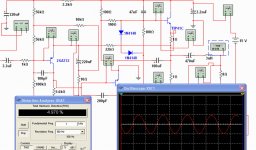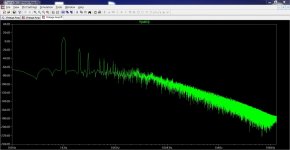Nice amp. Class A 2-stage amp with emitter follower loaded on gyrator.
Hi,
I've never seen a gyrator load like this before, seen a choke obviously.
One does wonder about the size of the capacitor for the gyrator too.
(Unless its actually a variation on the White cathode follower.)
rgds, sreten.
I said about 3W based on the 15V supply shown. 23V allows more.
Last edited:
It looks like a simple bootstrapped load to me. The drawing puts the components in unfamilar places, so the circuit operation is somewhat obscured.
Agree.
I see no gyrator there, but a simple single supply single transistor front-end amplifier.
I remember when they were "state of the art", go figure
I see no gyrator there, but a simple single supply single transistor front-end amplifier.
I remember when they were "state of the art", go figure
Typical of some Grundig portable radio schematics drawings of the amp part , it looks
like they are doing their best to make you follow legnthily every single path
to check if it goes effectively where it is supposed to , indeed this is the same
schematics , wich apart from this originality is a typical CFB amp with
a simple complementary output pair , with of course a bootstrap that is more
than necessary given the low current gain of the final stage as well as the limited
VAS current , on the order of 10mA in this case , wich will likely make the output
stage run out of gain at high level , surely an important parameter in the final sound.
like they are doing their best to make you follow legnthily every single path
to check if it goes effectively where it is supposed to , indeed this is the same
schematics , wich apart from this originality is a typical CFB amp with
a simple complementary output pair , with of course a bootstrap that is more
than necessary given the low current gain of the final stage as well as the limited
VAS current , on the order of 10mA in this case , wich will likely make the output
stage run out of gain at high level , surely an important parameter in the final sound.
The VAS current is defined by its loading resistors , 390 + 220 = 610R
with about 7V to shift , the current is 11mA.
with about 7V to shift , the current is 11mA.
The VAS current is defined by its loading resistors , 390 + 220 = 610R
with about 7V to shift , the current is 11mA.
Ops! You're right !
1mA is on the first stage
Sorry.
My mistake, the diode is supposed to be two diodes in series. The 10 ohm resistor in the feedback circuit is right. The 47K on the capacitor is 47,000pf. The amp has alot of gain, has some ringing on square wave test, four bumps on the leading edge. This leads me to believe that the neg feedback can't be increased much. It does oddly manage to have almost no crossover distortion (can't even see it on the scope). 3db points are 80hz flat to 50khz, with usable bass down to 55hz (possible predistortion in preamp). Power supply is around 23v. There's no way it's only 3 watts, has to be at least 7 per side (it can shake the floor). It's not a serious amp power wise, it's just the only transistor amp I've ever heard that sounds like a single ended tube amp. When under 2 watts it just sounds so clear, it kind of baffles me how such cheap components, weird "or poor" design choices can come together and sound really good. I just posted it to see of the topology of the amp could be built into a more powerful amp. I just figure that if such poor components can sound good, then better parts and fine tuning of values might lead to really great sounding amp. There's something to be said for a design that has a gradual increase in distortion with power. But I do consider this amp to be hi-fi, it's just not going to rock the house. Most of the time I listen to music under 5 watts anyway, if I want loud I use a more typical transistor amp. It can go loud, then it's bass gets really sucky.
Keith
Take a look at the "Amp Camp Amp" in the Pass Labs forum. It's a simple MOSFET class A power amp that runs off of a 19V laptop power supply. Disconnect the 68.1K feedback resistor and it sounds more like a tube amp than some tube amps. The only things missing are the saggy power supply and the noise.
It looks like a simple bootstrapped load to me. The drawing puts the components in unfamilar places, so the circuit operation is somewhat obscured.
You are right, I missed the diode. 🙂
No gyrator, just bootstrapped complementary emitter follower. My imagination improved it a little bit. 😀
Last edited:
I will adapt it to silicon devices and will simulate
Depending second and third harmonics results i will assemble to listen.
It is interesting....and if musicians said it sounds good..then i want to check that.
These guys that works with music usually have excellent ears...they are highly skilled related sonic evaluation...well...this is what they do all time long.... i do respect them and i do not discuss with them because for sure they gonna win the discussion in the end of the tests.
regards,
Carlos
Depending second and third harmonics results i will assemble to listen.
It is interesting....and if musicians said it sounds good..then i want to check that.
These guys that works with music usually have excellent ears...they are highly skilled related sonic evaluation...well...this is what they do all time long.... i do respect them and i do not discuss with them because for sure they gonna win the discussion in the end of the tests.
regards,
Carlos
I'll post some scope shots tomorrow. I would have posted them sooner, but I'm almost embarrassed to post them, kind of makes me look like I'm crazy. They won't be pretty, and they are guaranteed to make me look like a fool, or someone who likes distorted sound. But I'll do it anyway. I should print a disclaimer on the pictures "it sounds better than it appears".
I would love to post the preamp schematic, if it were only that easy. I reverse engineered this.3
schematic, and that's the simple part of the amp, the preamp has way more components than the power amp section, despite it not even having a phono stage. I have once copied the amp circuit and tried it, and it sounds much different than the original. I think they designed them to work together. Since there's so many people interested, I'll reverse engineer the preamp too. It's not fair to just give people only half an amp.
I wonder how the condition of the components in the amp changes the sound quality. Several capacitors in the amp are over-voltaged from the factory. Like in the preamp there's a 25v 1000uf with 33 volts on it. Alot are 25v with 27 volts on them. No circuit fault, they just put too low of voltage caps in several places of the amp. I'm kind of amazed, it seems if a cap has seen too high of voltage since day one, then it's okay with it, like it becomes used to the voltage. I know all about the volt rating of caps and would never purposely do that to a circuit, it's literally playing with fire. In the amp the cap has alot of resistance in front of it, like 1K, so if it shorted, nothing would explode. I think it's for the tape amp section. It's worth noting this amp has nothing to to with the tape recorder, that has a separate chassis.
I wonder if I could post a sound clip somehow?
Keith
I would love to post the preamp schematic, if it were only that easy. I reverse engineered this.3
schematic, and that's the simple part of the amp, the preamp has way more components than the power amp section, despite it not even having a phono stage. I have once copied the amp circuit and tried it, and it sounds much different than the original. I think they designed them to work together. Since there's so many people interested, I'll reverse engineer the preamp too. It's not fair to just give people only half an amp.
I wonder how the condition of the components in the amp changes the sound quality. Several capacitors in the amp are over-voltaged from the factory. Like in the preamp there's a 25v 1000uf with 33 volts on it. Alot are 25v with 27 volts on them. No circuit fault, they just put too low of voltage caps in several places of the amp. I'm kind of amazed, it seems if a cap has seen too high of voltage since day one, then it's okay with it, like it becomes used to the voltage. I know all about the volt rating of caps and would never purposely do that to a circuit, it's literally playing with fire. In the amp the cap has alot of resistance in front of it, like 1K, so if it shorted, nothing would explode. I think it's for the tape amp section. It's worth noting this amp has nothing to to with the tape recorder, that has a separate chassis.
I wonder if I could post a sound clip somehow?
Keith
I'll post some scope shots tomorrow. I would have posted them sooner, but I'm almost embarrassed to post them, kind of makes me look like I'm crazy. They won't be pretty, and they are guaranteed to make me look like a fool, or someone who likes distorted sound. But I'll do it anyway. I should print a disclaimer on the pictures "it sounds better than it appears".
Not at all. I post many many scope shots on here to get a point across. Even sussed out how to attach video clips (without youtube 😀)
A sound clip probably wouldn't reveal much tbh because its not the same as hearing it in situ driving the real speakers.
I would suggest trying around 1Khz and 10Khz square wave tests at around a couple of volts peak to peak output into 8 ohms.
A sound clip probably wouldn't reveal much tbh because its not the same as hearing it in situ driving the real speakers.
Well, a sound clip can give you a good indication of the system.
Here is an example: Voxative Acoustic, KR Audio, Gregitek, highend electronics - YouTube
Play it in HD mode.
It is not promising into the simulator.
to me this is enough...biasing is wrong...i had to tweak a lot, fourier analises result in a tragedy......3.5 volts in the output..too much sensitive in the input...well...i give up about this one.
But i do like to listen...set a movie camera and make a recording..then post it in Youtube.
You see...it is possible to make reasonable recordings if you use 1 watt and 1 meter from the speaker....have to use matresses and all absorbing material around...it is not that easy..also have to enter a digital processor to remove noise from the recording....hissing noise.
Camera was Kodak Playfull Ze1, one meter distance and microphone sensitivity reduced to the maximum i could.... a fifty dollar camera did this job..imagine a good one what can do.
Dx Super A - MKII - good sound with poor speaker - YouTube
regards,
Carlos
to me this is enough...biasing is wrong...i had to tweak a lot, fourier analises result in a tragedy......3.5 volts in the output..too much sensitive in the input...well...i give up about this one.
But i do like to listen...set a movie camera and make a recording..then post it in Youtube.
You see...it is possible to make reasonable recordings if you use 1 watt and 1 meter from the speaker....have to use matresses and all absorbing material around...it is not that easy..also have to enter a digital processor to remove noise from the recording....hissing noise.
Camera was Kodak Playfull Ze1, one meter distance and microphone sensitivity reduced to the maximum i could.... a fifty dollar camera did this job..imagine a good one what can do.
Dx Super A - MKII - good sound with poor speaker - YouTube
regards,
Carlos
Attachments
Last edited:
So called tube sound come from the upper power device being current
base starved at high output power while the negative side can supply
enough current thanks to the VAS not being current limited , hence
the circuit will clip assymmetricaly , firstly on the positive side of the signal
wich will in principle induce high level even harmonics.
I guess that overall it is the sound of a poorly behaving tube amp......
base starved at high output power while the negative side can supply
enough current thanks to the VAS not being current limited , hence
the circuit will clip assymmetricaly , firstly on the positive side of the signal
wich will in principle induce high level even harmonics.
I guess that overall it is the sound of a poorly behaving tube amp......
This is the distortion plot at 1 watt into 8 ohms in Ltspice.
No wonder it is said to sound so sweet! It has relatively high levels of monotonically decreasing harmonic distortion. This creates a "fat" sound like certain classic tubes ie 6SN7.
Sound tests, recording with digital camera, if good camera
can show you quality..... this is the best sound i have found in the internet
This one is Class D, but has error correction, a kind of digital negative feedback applied.
This one beat mine amplifiers.... or matches, as i have no KEF speaker to test together my ones..but this one is really awesome.... I use to say that i gonna eat my amplifier if you find another one able to beat it..... i will have to say this exception.... this NAD together this KEF is one exception.
Listen the quality.... we can perceive quality easy..even if recording is not that good.
You see audio does not scratch as a demo published from some tube amplifiers that sounded very bad in my opinion.
NAD C390DD.... this one is hard to beat.
KEF LS50 SPEAKERS - YouTube
http://www.youtube.com/watch?v=8jA9zOr-1e0
regards,
Carlos
can show you quality..... this is the best sound i have found in the internet
This one is Class D, but has error correction, a kind of digital negative feedback applied.
This one beat mine amplifiers.... or matches, as i have no KEF speaker to test together my ones..but this one is really awesome.... I use to say that i gonna eat my amplifier if you find another one able to beat it..... i will have to say this exception.... this NAD together this KEF is one exception.
Listen the quality.... we can perceive quality easy..even if recording is not that good.
You see audio does not scratch as a demo published from some tube amplifiers that sounded very bad in my opinion.
NAD C390DD.... this one is hard to beat.
KEF LS50 SPEAKERS - YouTube
http://www.youtube.com/watch?v=8jA9zOr-1e0
regards,
Carlos
Last edited:
can show you quality..... this is the best sound i have found in the internet
This one is Class D, but has error correction, a kind of digital negative feedback applied.
This one beat mine amplifiers.... or matches, as i have no KEF speaker to test together my ones..but this one is really awesome.... I use to say that i gonna eat my amplifier if you find another one able to beat it..... i will have to say this exception.... this NAD together this KEF is one exception.
Listen the quality.... we can perceive quality easy..even if recording is not that good.
You see audio does not scratch as a demo published from some tube amplifiers that sounded very bad in my opinion.
NAD C390DD.... this one is hard to beat.
KEF LS50 SPEAKERS - YouTube
Audio Advisor - NAD C 390DD Direct Digital DAC Amplifier - YouTube
regards,
Carlos
Do they do Rock and Roll?
- Home
- Amplifiers
- Solid State
- Tube sound from a transistor amp, it's possible


